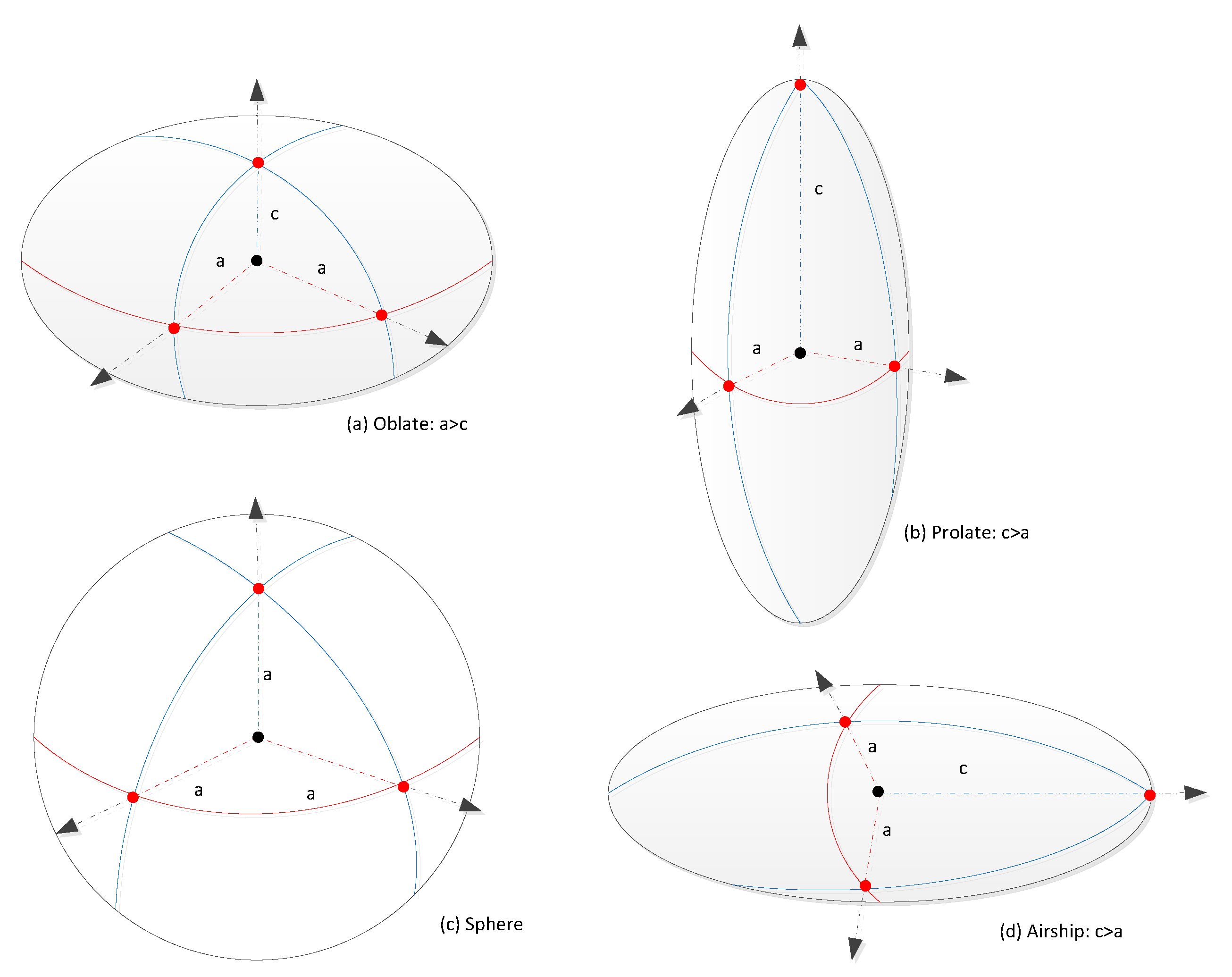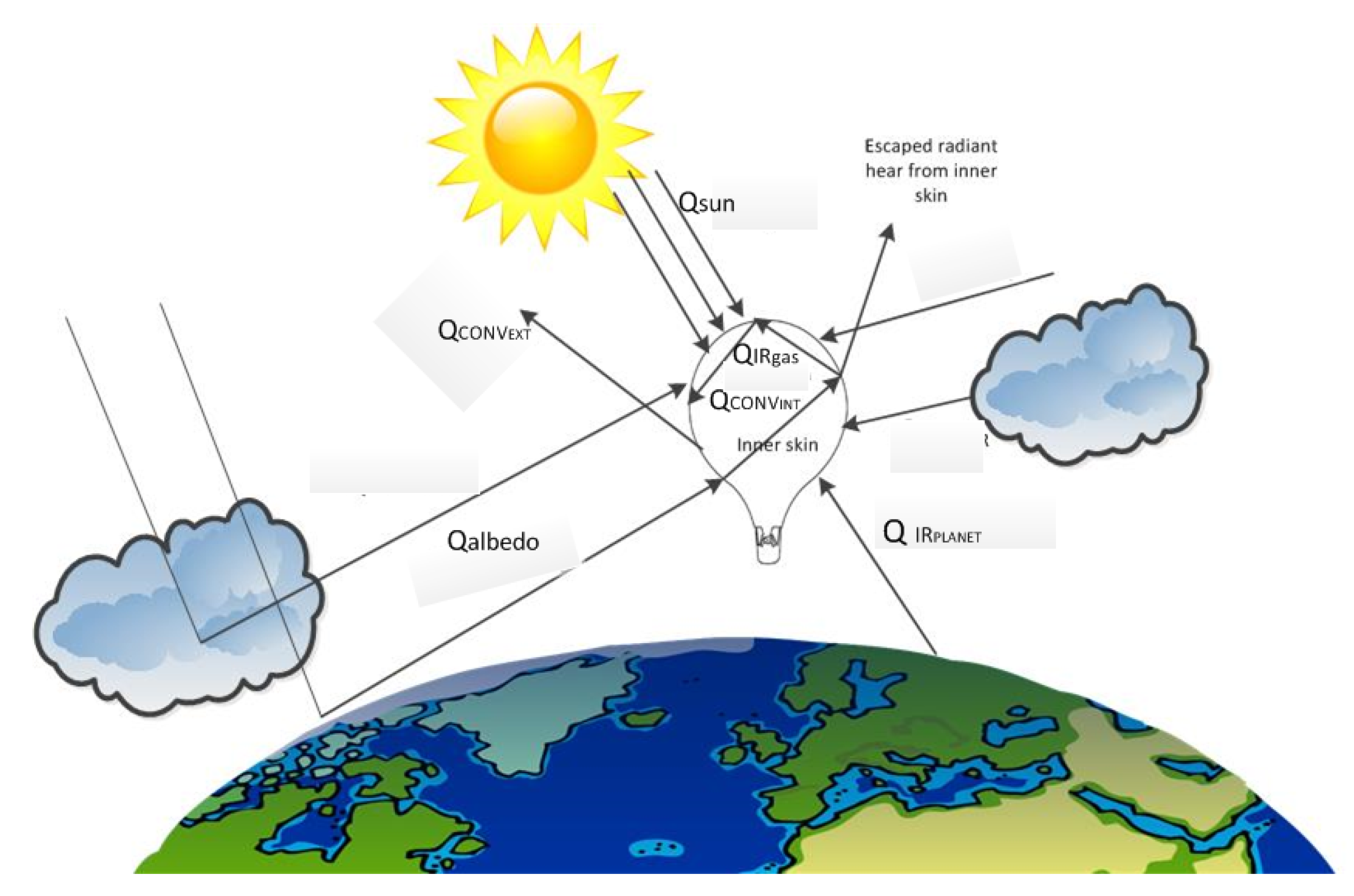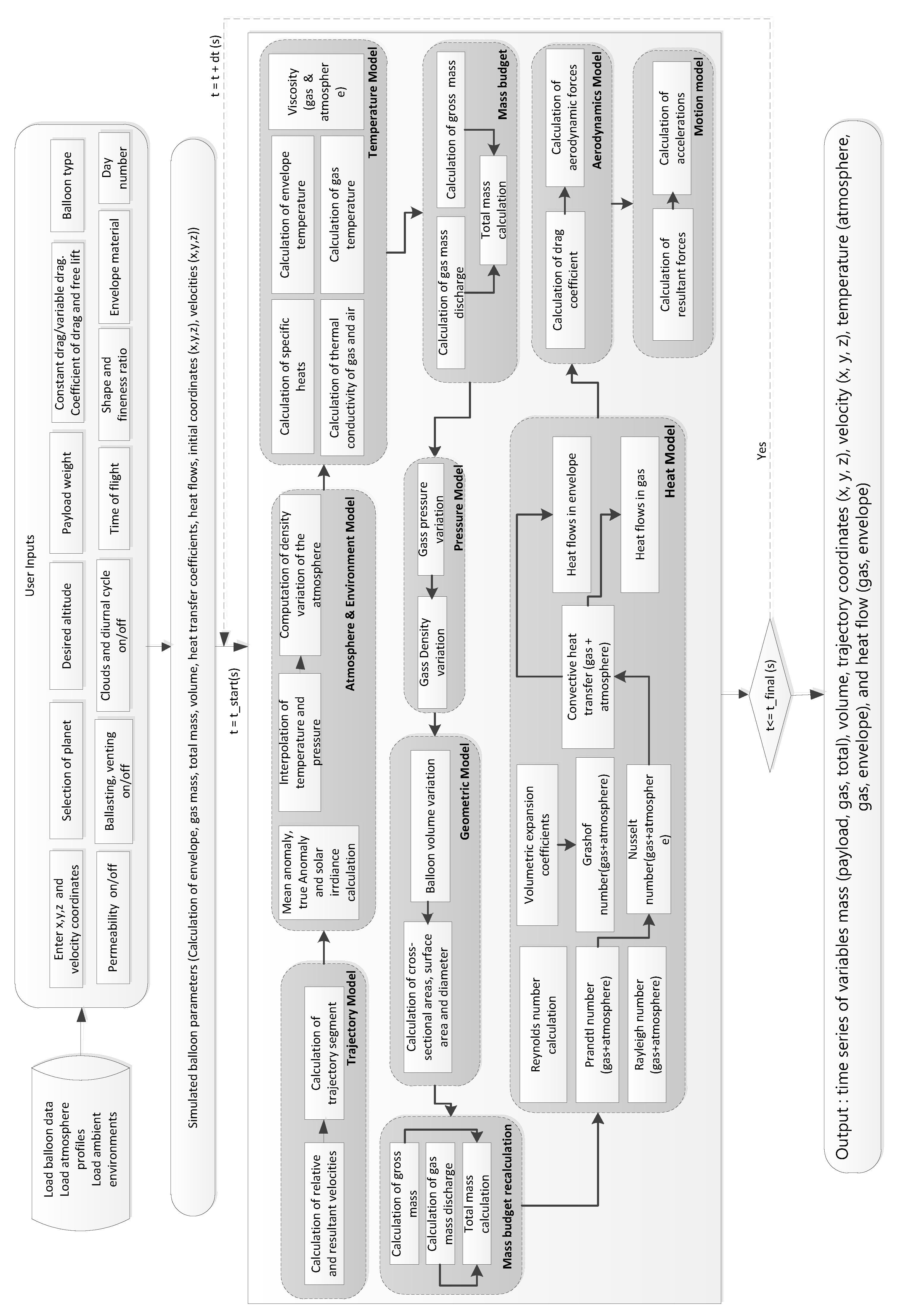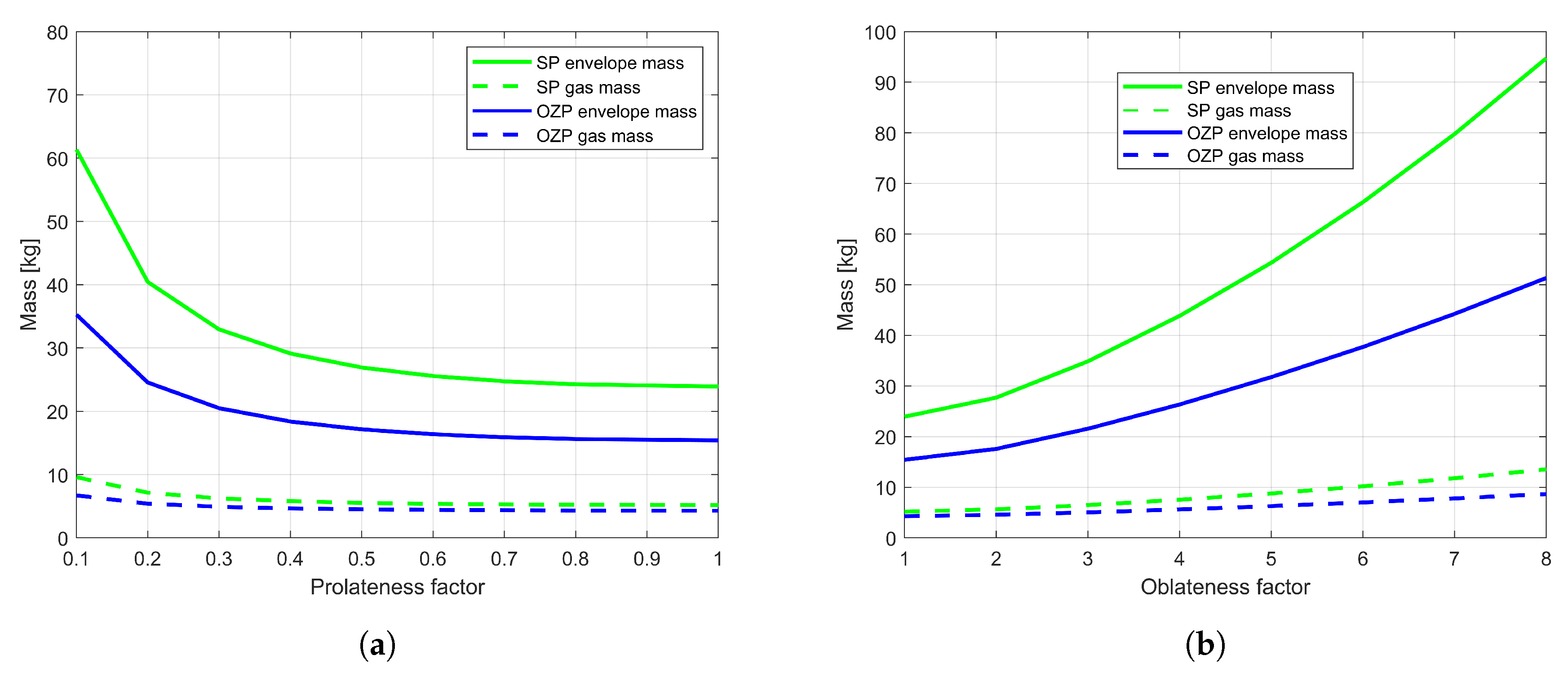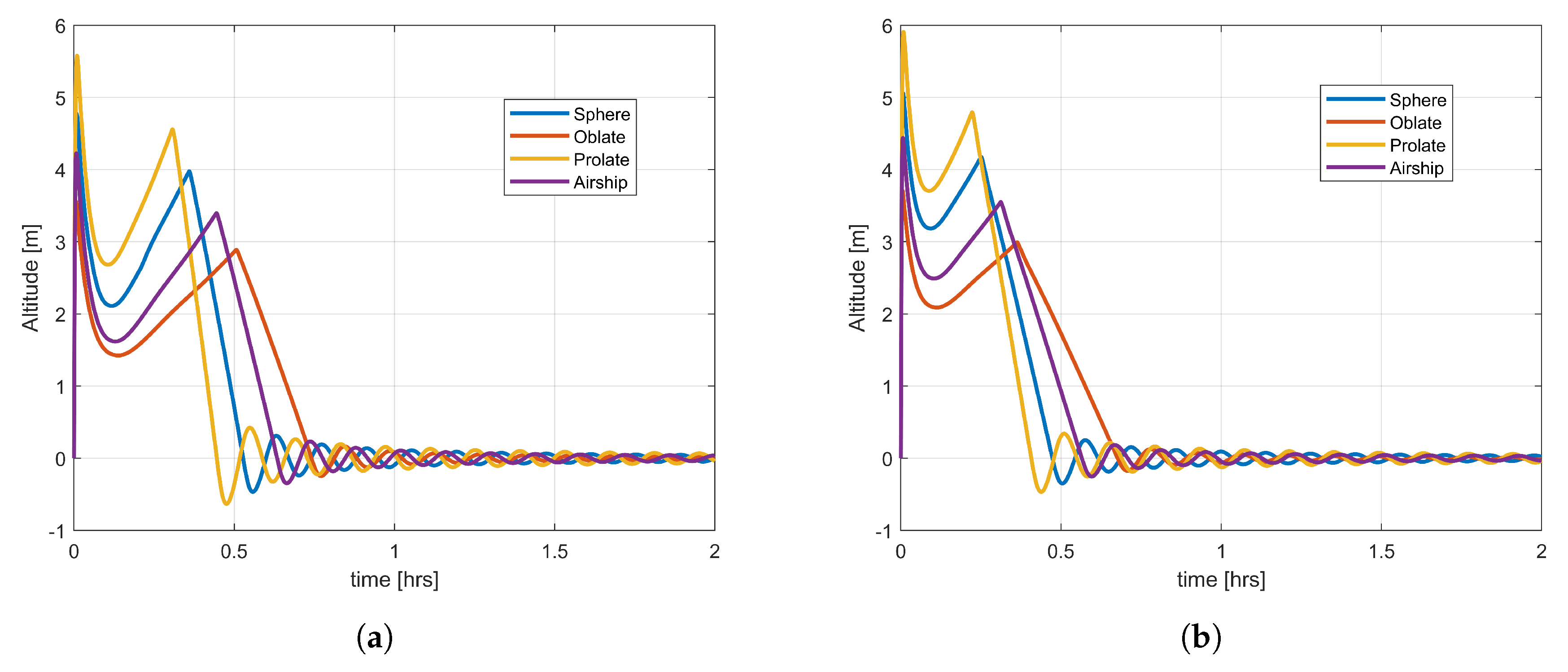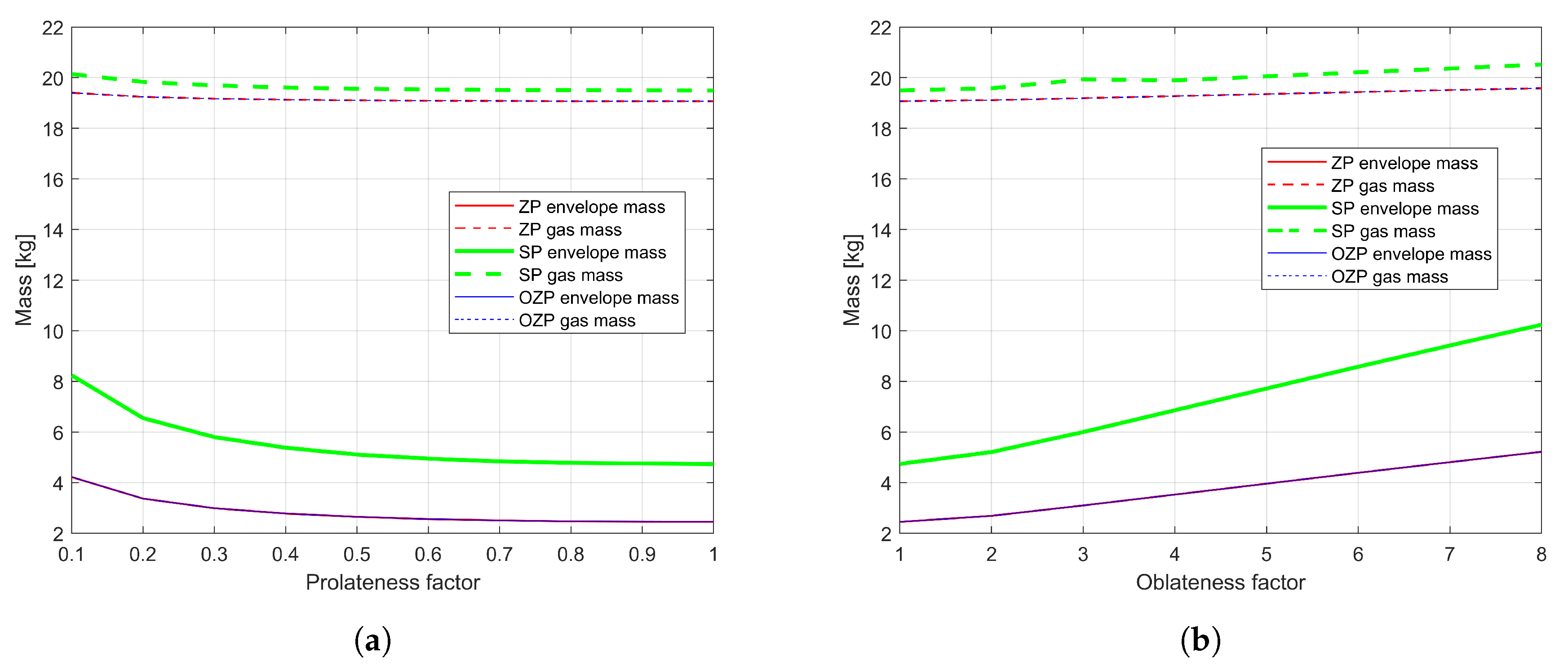This Section illustrates the simulated balloon behaviour for different design options for Venus, Mars, and Titan. The various design specifics for these balloons have been taken from various feasibility studies [
14,
40,
43].
Section 4.1 illustrates the simulated behaviour of ZP, SP, and OZP balloons for Venus. For Mars,
Section 4.2 presents only the SP and OZP balloon simulations, as ZP balloons are not feasible. In case of Titan, all three balloon type simulations with different shapes are presented in
Section 4.3.
4.1. Balloons on Venus
The wind circulations and high density of the Venusian atmosphere make it an interesting candidate for balloon exploration [
7]. The VEGA balloons deployed in the Venusian atmosphere in 1985 as a collaboration between USSR, French, and US scientists were the first planetary exploration balloons [
44]. These spherical SP balloons operated for about 2 Earth days at an altitude of 50–54 km over the surface of Venus and succeeded to observe the wind pattern at such altitudes until their batteries were depleted. Since then various studies have suggested the use of balloons for Venus exploration [
45].
The main advantage of using SP balloons is their ability to maintain a stable altitude under atmospheric turbulence and diurnal solar flux variations. While various studies have illustrated the importance of spherical SP balloons for Venus [
43,
46,
47], not much is said in the literature about the feasibility of ZP and OZP balloons for Venus explorations. This Section presents a comparative analysis of the three types of balloons (ZP, SP, and OZP) for exploring Venus.
At an altitude of 52–53 km, Venus resembles the atmosphere of Earth except for the presence of sulphuric acid and haze-like clouds. Permanent winds of magnitude 65 m/s to 100 m/s in clockwise direction are common and provide many advantages to balloon flights [
48]. To survive the contact with the sulphuric acid, the balloon envelope has to be chosen with utmost care. The Jet Propulsion Laboratory (JPL) has suggested the use of fluoropolymers, PTFE (polytetrafluoroethylene) & PFA (perfluoroalkoxy polymer) as a protective layer on the Mylar film as this combination has extremely low permeability and can cease the effect of sulphuric acid [
49]. For deploying the balloon on Venus, aerial deployment is preferred. In [
17], the authors suggest that for lifting a 0.31 kg net payload mass (i.e. without gas tank), a balloon would have a diameter of around 0.4 m. For an exploratory balloon on Venus, certain envelope characteristics, payload mass, and float altitude have been suggested in the literature [
43,
47,
50], and on the basis of these studies, the parameters used for simulating the balloon flight on Venus have been chosen and are listed in
Table 4.
Figure 5,
Figure 6 and
Figure 7 illustrate the ascent behaviour of oblate, prolate, and airship shape ZP, SP, and OZP balloons for several fineness ratios. The behaviour of oblate, prolate, and airship ZP balloons can be seen in
Figure 5. In the case of oblate shape ZP balloons, with the increase in oblateness (increase in fineness ratio), the cross-sectional area
of the balloon increases, and as a result the drag acting on the balloon also increases. Consequently, the ascent speed of the balloon decreases. In the case of prolate shape ZP balloon, with the increase in prolateness (i.e., decrease in fineness ratio), the
decreases, as a result the drag acting on the balloon decreases. Hence, the balloon with high prolateness ascends faster than the balloon with low prolateness. For the airship shape balloons, with the increase in prolateness, the
increases and as a result, the drag increases and the ascent speed of the balloon decreases.
For the prolate shape ZP cases, balloons with prolateness between 0.1–0.4 reach the float altitude but then start to descend again. While the balloon ascends, the temperature of the lifting gas decreases due to adiabatic expansion at a faster rate than the temperature of the surrounding atmosphere, which follows the atmospheric temperature lapse rate. Initially, this leads to the lifting gas being colder than the atmosphere. However, with increasing temperature difference, convective heat transfer becomes more important. Eventually, at the float altitude, thermal equilibrium is reached. Because of solar heat input, may then be higher than the atmosphere, as is the case for the Venus simulations. The state of neutral buoyancy and thermal equilibrium is complex due to all involved heat flows and forces and the balloon oscillations around this equilibrium state. The instability in case of more pronounced prolateness may be due to the increased surface area, affecting the heat flows, and the decreased , reducing the drag. Both effects combined lead to increased balloon speed before and during the oscillations around float altitude, which in turn can cause instability.
Figure 6 and
Figure 7 illustrate the behaviour of SP and OZP balloons for the different shapes with varying fineness ratios. Similar to the ZP oblate balloons, both SP and OZP oblate shape balloons achieve stability for different fineness ratios. Also, in the case of prolate shape, unlike ZP, both SP and OZP balloons are able to stay afloat at all the fineness ratios. SP and OZP balloons allow higher than atmospheric pressure, and therefore, have a fixed volume at the float altitude, i.e., the volume does not increase or decrease with a change in gas and atmospheric temperature, and, hence, these balloons tend to stay afloat for long durations, irrespective of the configuration of the shape.
Figure 8 presents the envelope mass and gas mass variation for ZP, SP, and OZP balloons at varying oblateness and prolateness. The envelope mass of ZP and OZP balloons are very similar as the envelope properties for these balloons are the same. The SP balloon envelope mass is heavier in comparison, as the envelope used has higher density in addition to a larger balloon volume required. The envelope and gas mass increase linearly with an increase in oblateness for all three types of balloons and can be seen in
Figure 8a. For prolate and airship, the envelope and gas mass decreases linearly as the prolateness decreases towards a spherical shape (
Figure 8b). For ZP and OZP to reach the same float altitude as SP, slightly less gas mass is needed.
Next, the behaviour of different shapes of ZP, SP, and OZP balloons were compared with a sphere shape. A fineness factor of 3 was chosen for oblate shape, 0.6 for prolate shape, and 0.4 for airship shape as all three types of balloons are stable at these fineness ratios.
Figure 9 presents the ascent speed variation for the three types of balloon and four different shapes. The balloon ascent speed increases or decreases in accordance with the variation in altitude and fluctuates around zero when the balloon reaches the stable altitude. After reaching the stable altitude, the balloon moves in the direction of the wind and only ascends or descends if ballasting and valving operations are applied to the balloon system. The flight behaviour of the different shapes varies. The prolate shape has the highest velocity while the oblate shape has the least velocity, for all three types of balloon. There are almost no altitude excursions for these shapes after the balloon reaches the stable altitude and, hence, the velocity is almost zero.
To summarise the design concept of the balloon on Venus, the following two criteria can be used: mass efficiency and time to reach the float altitude. If one wants to use prolate shape in the case of ZP balloons, then only certain configurations are stable (fineness above 0.3). For SP and OZP balloons, while the flight performance is almost similar for all shapes, the total mass of the balloon system varies. The oblate shape balloons with a fineness ratio above 4 and prolate and airship shape balloons with a fineness ratio below 0.3 are much heavier in comparison to the sphere. If the mission needs the balloon to ascend slowly and have no constraints on the mass of the balloon system, the oblate shape can be a preferred option; if the mission demands a faster ascent, then the prolate shape can be a preferred choice; if the mass efficiency is the major requirement than the spherical balloon of ZP, SP, or OZP can be used.
4.2. Balloons on Mars
The atmosphere on Mars has a low density in comparison to those of Earth and Venus, which makes the balloon flight operation difficult on the surface of Mars. Mars also has extreme temperature variations (
100 K and
50 %) which increases the challenges related to the balloon flight. At low altitudes on Mars, the balloon flight is similar to flying in the Earth’s stratosphere as pressure and density are similar, and, therefore, the performance metrics in terms of the balloon material mass per unit area and volume are comparable [
50,
51]. On Earth, ZP balloons are typically flown at these altitudes, but due to the high temperature variation in day-to-night, these balloons are impractical in the Mars atmosphere, as they have to deploy significant amount of ballast in order to stay afloat, fact that the lifetime of these balloons brief, i.e., few days. This characteristic of ZP balloons makes them unattractive for operation on Mars as they have to carry extra mass, and in addition are not able to collect enough data ‘geographically and temporally’ [
52] due to limited lifetime in order to justify the high cost of the mission. The two types of balloons that seem viable options for Mars are the SP and OZP.
Over the years, a number of conceptual and experimental studies have been done for balloon missions on Mars [
50,
51,
53]. In [
17], the authors suggest that for lifting a 15.8 kg net payload mass (i.e., without gas tank), a balloon with a diameter of around 8 m would be required. While none of these studies have given a detailed analysis of different shapes for the balloon mission on Mars, they do suggest some important design parameters.
Table 5 shows the parameters that will be used for simulating the balloon behaviour on the surface of Mars. Similar to the case of Venus, balloons will be aerially deployed to minimize the risks [
52].
Figure 10 presents the behaviour of prolate, oblate, and airship shapes at different fineness ratios for the SP balloons. All three shapes of SP balloons reach the desired float altitude. In the case of oblate shape SP balloons, the time taken by the balloon to reach the float altitude increases with the increase in oblateness (increase in fineness ratio). As the oblateness increases, the cross-sectional area of the balloon increases, so does the drag, and due to the increase in drag, the velocity of the balloon decreases. Therefore, with the increase in oblateness in
Figure 10a, the time taken by the balloon to reach the float altitude also increases. The behaviour of the prolate shape SP balloons is illustrated in
Figure 10b. With increase in prolateness (decrease in fineness ratio),
decreases, which reduces the drag. Consequently the balloon ascends faster, which leads to larger oscillations around the float altitude. In the case of airship (
Figure 10c), with the increase in prolateness (decrease in fineness ratio),
increases, and, hence, the drag. Therefore, the time taken by the balloon to reach the float altitude increases.
The behaviour of the OZP balloons with varying shape and fineness ratios can be seen in
Figure 11. The OZP balloons reach the desired float altitude. The time to reach the stable float altitude for different shapes at varying fineness ratio illustrates a behaviour similar to that of the SP balloon oblate, prolate, and airship shapes. Further, the OZP balloons of a particular fineness ratio ascend faster than the corresponding SP balloons of the same fineness ratio.
Figure 12 presents the mass characteristics for the SP and OZP balloons of different shapes with varying fineness ratios. The OZP balloons are heavier than the SP ones in terms of both gas and envelope mass. For oblate shape SP and OZP balloons, the mass of both envelope and gas increases with increase in the fineness ratio. The envelope mass of the balloon with oblateness = 8 is almost 3 times that of the balloon with oblateness = 2 for both SP and OZP balloons (
Figure 12a). In the case of prolate and airship shapes as the prolateness decreases towards sphere, the envelope mass also decreases. The envelope mass of the balloon with a prolateness of 0.1 is twice that of the balloon with prolateness of 0.8 (
Figure 12b). The gas mass for oblate shape increases with an increase in oblateness and for prolate shape it decreases with a decrease in prolateness.
In order to compare the behaviour of different shapes of the SP and OZP balloons with a sphere shape, a fineness factor of 0.4 for airship and 0.4 for prolate and airship, and 4 for oblate shape were used.
Figure 13 presents the ascent speed variation of these shapes. Once deployed, it takes almost one hour for different shapes of the SP and OZP balloons to reach the stable altitude. The prolate shape for both SP and OZP balloons has the highest ascent velocity in comparison to that of the other shapes. The OZP balloon shapes have higher ascent speed in comparison to the corresponding shape of the SP balloons. For both SP and OZP different shapes, there are almost no oscillations in velocity once the balloon reaches the stable altitude.
For the balloon mission on Mars, the OZP balloons are in general more mass efficient. For both SP and OZP balloons it is preferred to use the balloons with low oblateness, a low prolateness or sphere. In terms of flight behaviour, the OZP balloons have a faster ascent speed, in comparison to that of the corresponding SP shapes. In terms of flight characteristics depending upon the requirements, all shapes for both OZP and SP balloons can be used, except a highly prolate shape as it ascends and oscillates very fast; therefore, it might be at risk to loose its heat and eventually burst.
4.3. Balloons on Titan
Titan is a unique place in the solar system [
54,
55]. The Cassini-Huygens mission revealed Titan to be a complex and fascinating world with diverse topographical features, and a methane based hydrological cycle [
56]. Since then, buoyant vehicles have gained the recognition that they can provide an outstanding and unmatched means of in-situ exploration on a global scale on the surface of Titan [
56].
Titan’s low gravity, thick atmosphere, and Earth like characteristics make it a perfect candidate for exploration using an atmospheric flight. Titan’s air density is 4 times that of the Earth at sea-level, the surface pressure is 1.5 times that of the Earth, and the surface temperature is −93 K. While the air density supports a balloon mission on Titan, the temperature makes it challenging. Too low temperatures can make the material brittle; therefore, the material used for the balloon fabrication on Titan has to be chosen with utmost care. Further, the atmospheric models of aerosols and precipitation indicate methane clouds at 10–35 km of altitude, which suggests that the balloon should be deployed at an altitude below 10 km [
57]. On Titan, the near-surface winds are expected to be <1 m/s up to an altitude of a few hundred meters (the planetary boundary layer thickness). At 10 km altitude, the winds are predicted to be around 1.0–2.5 m/s towards East [
58], which enables the global coverage of Titan.
Studies suggested three types of balloons, ZP, SP, and Montgolfière for a mission on Titan [
14,
56]. Montgolfière balloons are a type of ZP balloons, which use heated ambient air instead of helium and hydrogen. The use of OZP balloons on Titan has not been mentioned in the literature. In this paper, the performance of three types of balloons, i.e., ZP, SP, and OZP, with 4 different shapes is analysed. For Titan’s cryogenic environment, use of a radioisotope power source (100 W for a mass of 20–40 kg) is needed for all balloon concepts. Some suggestions have been made regarding the payload mass, the balloon envelope material, and the float altitude in the literature [
56,
59]; these parameters are used for simulating the behaviour of different types of balloons and shapes on the Titan’s surface.
Table 6 summarizes these parameters.
Figure 14,
Figure 15 and
Figure 16 present the behaviour of oblate, prolate, and airship shapes for ZP, SP, and OZP balloons and varying fineness ratios. The ZP and OZP balloons tend to reach the desired float altitude. The time taken by the ZP and OZP balloons to reach the stable altitude is more than that of the SP ones for similar shape and fineness ratio. The behaviour of the ZP and OZP balloons is similar (at the same shape and fineness ratio); the time taken by these balloons to reach the float altitude is also similar (
Figure 14 and
Figure 16). For oblate and airship shape of ZP, SP, and OZP, as the oblateness (increase in fineness ratio) and prolateness (decrease in fineness ratio) increases the amount of time it takes the balloon to get stabilized at float altitude increases. In the case of prolate shape, with the increase in prolateness, the time to reach the stable float altitude decreases.
Figure 17 illustrates the envelope and gas mass variation for the ZP, SP, and OZP balloons at varying fineness ratio. The envelope and gass mass of the ZP and OZP balloons are similar and less than that of the SP ones at different fineness ratios. In the case of different shapes, and an increase in prolateness and oblateness, the envelope and gas mass increase. The oblate shape balloons are, in general, heavier than both prolate and airship in terms of both gas and envelope mass as can be seen in
Figure 17b.
Next, the sphere-shape balloons are compared with the oblate, prolate and airship shapes for the ZP, SP, and OZP balloons. The fineness factor used for comparison is 3 for oblate, 0.4 for airship and 0.6 for a prolate shape.
Figure 18 presents the ascent speed for all balloon types and shapes. The ascent speed of the ZP and OZP balloons is similar. The prolate-shape balloons for all three types of them have higher velocity, while the oblate shape has the least. The SP balloons for all shapes have velocity lower than the corresponding shapes of the ZP and OZP balloons.
To summarize, for the balloon mission on Titan, the OZP and ZP balloons seem to be more mass efficient than the SP balloons, which means that the latter balloons need almost twice the amount of gas. The envelope masses of ZP and OZP are similar, while the ZP balloons are slightly heavier. In the case of shape, it is preferred to use the prolate, airship, and oblate shapes with low prolateness, and oblateness factor. Balloons with high prolateness and high oblateness are heavier in comparison to a sphere. In terms of the ascent speed, if high ascent speed is desired, then the prolate shape could be a good choice; if low ascent speed is required then the oblate shape can be used.
